Making vegetable broth is one of those things that's really easy to do, but I bet most of us don't do it. Or, at least, don't do it often.
I use vegetable broth in a lot of my recipes, but I'll be honest, I often use store-bought broth. But I shouldn't because making your own vegetable broth is so, so easy. And you know what else? It tastes so much better too.
Unlike meat-based broths, there's no skimming off fat or any of that ickiness. You don't need to keep the pot on the stove for hours either. But it does require a little bit of advance planning. It also requires these three things:
Onions (or a member of the onion family--leeks or shallots work too), celery, and carrots. That's your starting point, but from there, you can tailor your broth to what you're going to be using it for.
And of course a pot! A large stock pot like this one will work best, or a Dutch oven is a great choice as well.
Add sprigs of thyme and parsley to make a cooking liquid for rice and other grains. If you're going to be using the broth as a base for an Asian-inspired soup (like this Thai Red Curry Soup), try adding fresh ginger and lemongrass.
Now, back to that thing I said about advance planning! You can buy whatever you want for your broth, chop it all up, and put it in your stockpot. But I'm cheap and it kills my soul a little to think about throwing away all those perfectly good veggies.
It's bad enough I have to throw away the onions, celery, and carrots!
So instead of buying what I need, I collect scraps in a freezer bag and when I have a few cups worth, I use them to make broth. Here's what I used in this particular batch:
But really, you can use so many different things. You do want to stay away from cruciferous veggies--no cabbage, no broccoli, no cauliflower, and for the love of all things holy, no brussels sprouts--because they can leave bitter flavors in your broth.
Make sure everything you use is clean too--you don't want to make dirt soup!
And remember, there's a difference between things you don't want to eat vs. things you shouldn't eat. Clean carrot peel is fine in a broth or stock; a moldy carrot is not.
Oh, and speaking of stock! Have you ever wondered the difference between vegetable broth and stock? Broth is seasoned, while stock is not.
So this recipe can be used for both vegetable broth or stock. To make stock, skip adding salt and pepper at the end.
And if you want to make your own broth, but aren't keen on the idea of using your veggie scraps, go check out this vegetable stock recipe too.
Recipe
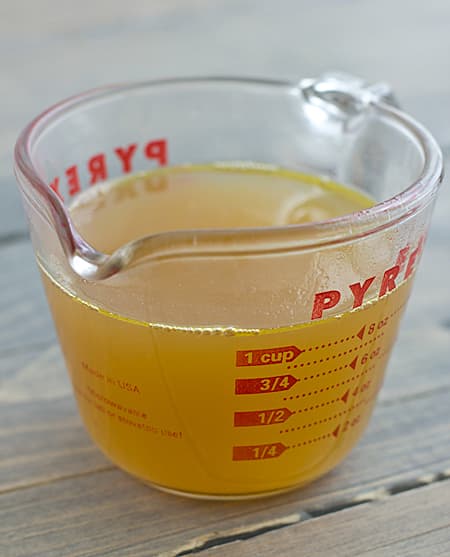
Equipment
Ingredients
- 1 tablespoon olive oil
- 5 cloves garlic minced
- 2 onions large, chopped
- 3 ribs celery chopped
- 3 carrots chopped
- 8 cups water
- frozen vegetable scraps 2-3 cups is a good amount
- 2 bay leaves
- parsley a few sprigs
- thyme a few sprigs
- salt and pepper to taste, omit if you are making stock
Instructions
- Heat the olive oil in a large Dutch oven or stockpot over medium heat.
- Add the garlic, onions, celery, and carrots. Cook until softened, about 5 minutes, stirring often.
- Add the water, frozen vegetable scraps, bay leaves, parsley, and thyme. Reduce heat to low and simmer, partially covered, for 45 minutes.
- Pour the broth through a fine mesh strainer into a large heat-proof bowl or pot; discard solids.
- Once the broth has cooled, transfer it to airtight plastic containers or freezer bags and store it in the freezer. (I usually freeze it in 2-cup portions so I don't have to thaw all the broth every time I use it.)
Nutrition
This post was originally published on January 8, 2013.



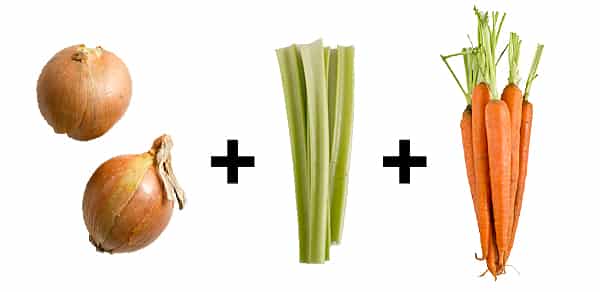
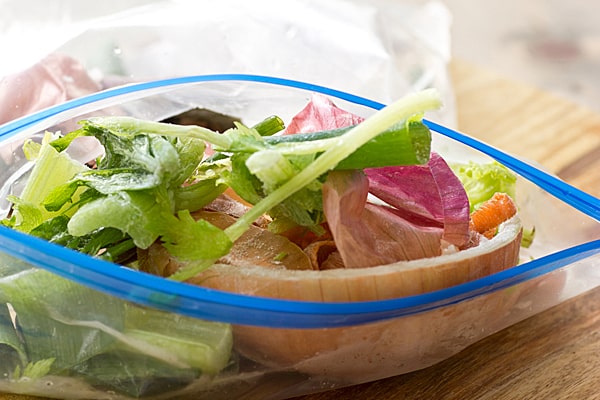
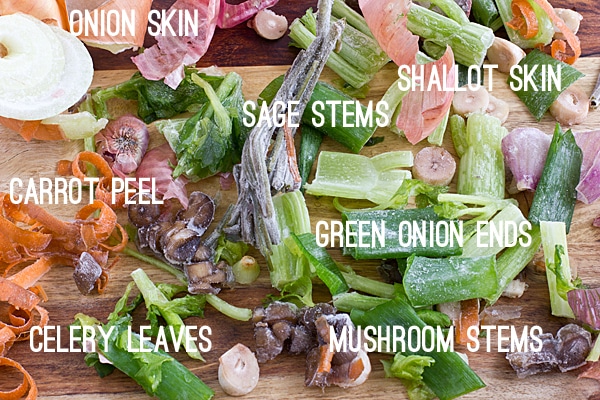
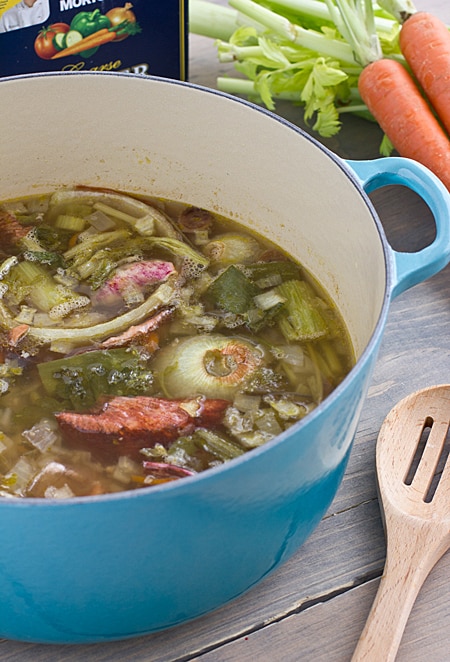
Molly McMahon says
Should it be brought to a boil before the heat is turned to low? Looking forward to making this!
Alissa says
Yup, you'll want to bring it to a boil first. I hope you enjoy it!
John says
I just made this and my wife brought up a good point... Normally you peel things so you don't have to scrub and wash them to remove the dirt/pesticides/etc. Shouldn't you be concerned about pesticide residue in the broth after cooking?
Alissa says
I would give everything a good cleaning before adding it to the broth, and if you're still concerned you could stick with organic produce.
Jay says
Just a note for those who don't know, organic produce also has pesticides, they are just organic. In some cases they are actually MORE toxic than regular pesticides. This is not to say organic produce is worst, to the contrary, but make sure you wash your organic produce as well!!
Anita says
When making vegetable stock, do most of the nutrients from the veggies leach into the stock so that it would have the same nutritional value (minus the fiber) as if you'd left the veggies in? Thank you for this.
Alissa says
Hi Anita! I would think some do, but I doubt all of the nutrients end up in the broth. I can't say for sure though!
kathleen says
Start with cold water to deglaze the onions and aromatics. Try for a 2 parts onion to one part carrot and one part celery for a balanced flavor. Do not boil, you want slight simmer of bubbles around the edge of the pot. boiling will tear apart the fibers and make your broth more cloudy and do not stir during the simmer process. I always strin in colander and then strain a second time in fine mesh sieve. Happy eating.
Chesca Barnett says
Thank you for this information!!!
O du viet nhat says
thanks you so much
marcia raymond says
is it bad to use kohlrabi for vegetable broth ?
JAMcD says
Kohlrabi is part of the brassica family - and she suggests avoiding all of those - brussel sprouts, broccoli, cauliflower, kale, rutabaga, collard greens, turnip, cabbage and most mustards.
I missed that, and currently am brewing a batch with sprout cuts in it - here's hoping it isn't wrecked...
Cat D says
I use a mixture of some or all of the following: broccoli stems, red and green cabbage, brussel sprout ends, kale, etc every time I make broth and it is delicious.
Julie Gardner says
Can I put all this into a slow cooker if so for how long
Alissa says
I think it would work in a slow cooker. I'd have to guess at the time, but I'd say around 4 hours on high, or about 8 on low.
Barbara says
Has anyone ever used corn cobs for this broth recipe? I"m wondering if corn milk released would make the broth cloudy and therefore not suitable....
CECILIA M STRAKNA says
The CSA cookbook by Linda Ly says that corn cobs are great in stock. Just break each cob in half.
Katelyn says
I cannot tell you how much this tip has helped me. I always keep a broth veggie bag in the freezer now. Thank you so much. This is such a money saver.
kelly says
Me too!!! I LOVED this idea & always have a bag for my veggie scraps too...LOL
Sambal Tumpang says
Should choose fresh vegetables, but I really like your idea.
Barbara says
What a great idea....keeping scraps in the freezer. I have never even thought about this until I saw a soup recipe that called for homemade vegetable stock, did a search for it and found your site. Can't wait to try it! Thanks for sharing!
Carla says
making this now using scraps I saved in freezer for like a month - I think I have too many veggies, but we'll see. Do you think this would work using the veggie "pulp"from my juicer? If I just make veggie juice - with carrots, celery, beets, kale or other greens?
Alissa says
I think that would work!
Vicki Stevenson says
Rather than straining this can I just zap it with the blender and enjoy????? Apologies in advance if thats a daft question!!
Rhae Redekop says
My broth separated when I thawed it (particles/sediment vs liquid) . Is it still ok to use?
Preston says
Yes, it should still be okay to use, but if it smells spoiled it's best to play it safe and throw it away. Assuming there is no odor, you can run your broth through a fine sieve to remove any unwanted sediment.
Ruth says
What if the majority of my scraps are tomato and cucumber and various fruits? Like when I make myself a huge salad, can those scraps be used as well?
Preston says
Hi Ruth! While there's no rule against it, typically tomatoes and other fruits are avoided because those flavors often clash with those of the scraps. Also, due to the high sugar content in many fruits, there's also an increased risk of the broth spoiling prematurely.
Anne says
Based on my culinary studies and having passed the national food-safety examination for certification, I respectfully disagree that sugar content increases the likelihood of spoilage. In fact, one of the ways that pre-refrigeration societies preserved foods was to sugar-cure them or “candy” them. However, the pH level (acid/base content) of a food does affects rate of growth of food-borne pathogens, so increased acids in a food tend to slow spoilage, but I have never read that sugar increases growth rate of pathogens. (Also, there are chefs who think that the flavor of tomatoes does not clash with onions and vegetables.)
Tiffany says
This is a really great idea! I've been wanting to make homemade veggie stock for a while, but thought it was a huge process. Now that I know that it's not, I'm totally going to try it.
How long should this last in the freezer?
A tip for some people worried about using scraps for there broth, I put scraps in the food processor, and mix it in with my dogs' food. They love it!
Katie Trant says
Hi Tiffany! Frozen broth should last you about three months in the freezer, so you'll have plenty of time to use it up!
Old Texan says
I rate the overall recipe 5 stars. I'm making it now.
Having worked in the production, distribution and use of vegetables, there is no way I will use peelings. Fruits and vegetables may have been subjected to
insecticide (even on organic, after leaving the field), bodily fluids and may be washed with dirty water. I can remember when, in South Texas, the dirt was washed off in the irrigation ditches. Fruits and vegetables that I am going to eat raw, I wash in a mild soap and bleach solution. Do you think workers in third world countries adhere to US food practices? If you can't stand to throw out peels, compost them and put around your plants, houseplants or yard and garden plants.
Macaroonmachine says
Please don’t ever bleach your food!
Thanks
Camilla says
I have looked for a good Vegetable Broth recipe, even using scraps, but they just didn't compare to this one. I am sharing it along with the adjustments I made with my family and friends. Thank you for very helpful tips!
Greg feil says
I’ve been making stocks and broths of all kinds for years...since I first started cooking, really. I can honestly say that it takes a lot of work to make a bad one and your instructions and explanation of the overall concept are perfectly easy to understand and are guaranteed to produce a delicious result. Having said that, I’m confused and slightly irritated by the barrage of unrelated questions and comments here in the comments and wish that common sense would come into play before posting. If you don’t like her recipe then look for another one and if you’re that inexperienced a cook just make it and see what happens. Throw it out if you don’t like it, but please stop with all the “What ifs” and “I wouldn’ts“ and scroll on past. She’s done a terrific job here.
Joanne says
I am making this vege stock specifically for cream of broccoli soup. Any reason not to use the trimmings from my broccoli stalks in my stock base?
Amanda Smith says
Hi! I have a lot of mushroom stems and asparagus stems along with celery onion and carrot. Would asparagus be ok or is it in the same family as brocolli and Brussels? I've made chicken stock before but never veggie.
Olga says
What a great idea! Love this. I’m sure this is incredibly delicious!
Anna says
Thanks! Made this last night so quick, easy and tasty!
Alina says
Nice idea! This broth look absolutely delicious! I need to try it!
Carolyn says
What if you can’t eat the onion family and garlic - what can I substitute for that.?